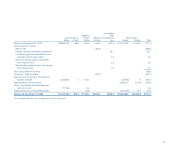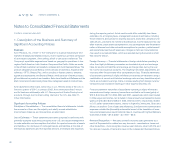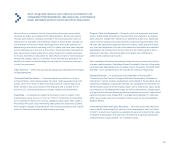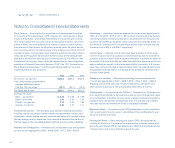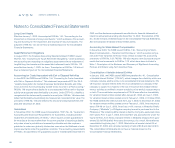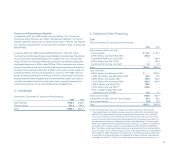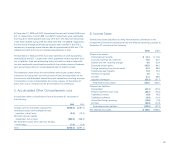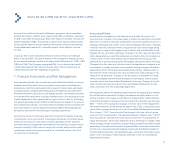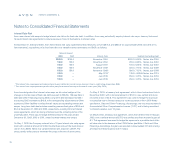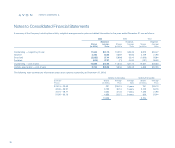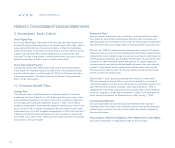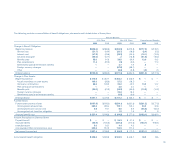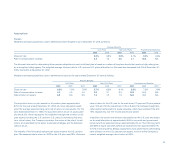Avon 2003 Annual Report Download - page 52
Download and view the complete annual report
Please find page 52 of the 2003 Avon annual report below. You can navigate through the pages in the report by either clicking on the pages listed below, or by using the keyword search tool below to find specific information within the annual report.
As a result of worldwide tax audit settlements, payments, net of associated
benefits and refund, of $45.1 were made during 2003. In addition, a payment
of $68.7 was made during January 2004 with respect to another tax audit set-
tlement recorded in 2003. The cash flow impact of this January 2004 payment
will be partially offset by the tax benefit on the interest portion of the payment.
These settlements resulted in a favorable impact on the effective tax rate
of 2.5%.
In January 2001, Avon received a federal income tax refund consisting of
$32.5 of tax and $62.7 of interest related to the carryback of foreign tax cred-
its and general business credits to the years ended December 31, 1982, 1983,
1985 and 1986. The Company recognized $40.1 as an income tax benefit
in 2000 resulting from the impact of the tax refund offset by taxes due on
interest received and other related tax obligations.
7. Financial Instruments and Risk Management
Avon operates globally, with manufacturing and distribution facilities in various
locations around the world. Avon may reduce its exposure to fluctuations in
earnings and cash flows associated with changes in interest rates and foreign
exchange rates by creating offsetting positions through the use of derivative
financial instruments. Since Avon uses foreign currency-rate sensitive and inter-
est-rate sensitive instruments to hedge a certain portion of its existing and fore-
casted transactions, Avon expects that any gain or loss in value for the hedge
instruments generally would be offset by decreases or increases in the value of
the underlying transactions. Avon also enters into foreign currency forward con-
tracts and options to protect against the adverse effects that exchange rate
fluctuations may have on the earnings of its foreign subsidiaries.
Avon does not enter into derivative financial instruments for trading or specula-
tive purposes, nor is Avon a party to leveraged derivatives. The master agree-
ments governing Avon’s derivative contracts generally contain standard
provisions that could trigger early termination of the contracts in certain circum-
stances, including if Avon were to merge with another entity and the credit
worthiness of the surviving entity were to be “materially weaker” than that
of Avon prior to the merger.
Accounting Policies
Derivatives are recognized on the balance sheet at their fair values. The
accounting for changes in fair value (gains or losses) of a derivative instrument
depends on whether it has been designated by Avon and qualifies as part of a
hedging relationship and further, on the type of hedging relationship. Changes
in the fair value of a derivative that is designated as a fair value hedge, along
with the loss or gain on the hedged asset or liability that is attributable to the
hedged risk, are recorded in earnings. Changes in the fair value of a derivative
that is designated as a cash flow hedge are recorded in other comprehensive
income (“OCI”) to the extent effective and reclassified into earnings in the
same period or periods during which the hedged transaction affects earnings.
Changes in the fair value of a derivative that is designated as a hedge of a net
investment in a foreign operation are recorded in foreign currency translation
adjustments within OCI to the extent effective as a hedge. “Effectiveness” is
the extent to which changes in fair value of a derivative offset changes in fair
value of the hedged item. Changes in the fair value of a derivative not desig-
nated as a hedging instrument are recognized in earnings in Other expense
(income), net on the Consolidated Statements of Income. Changes in the fair
value of a derivative are reported on the Consolidated Statements of Cash
Flows consistent with the underlying hedged item.
Avon assesses, both at the hedge’s inception and on an ongoing basis, whether
the derivatives that are used in hedging transactions are highly effective in off-
setting changes in fair values or cash flows of hedged items. Highly effective
means that cumulative changes in the fair value of the derivative are between
80% — 125% of the cumulative changes in the fair value of the hedged item.
The ineffective portion of the derivative’s gain or loss, if any, is recorded in earn-
ings in Other expense (income), net on the Consolidated Statements of Income.
Prior to June 1, 2001, Avon excluded the change in the time value of option
contracts from its assessment of hedge effectiveness. Effective June 1, 2001,
Avon includes the change in the time value of options in its assessment of
hedge effectiveness. When Avon determines that a derivative is not highly effec-
tive as a hedge, hedge accounting is discontinued prospectively. When hedge
accounting is discontinued because it is probable that a forecasted transaction
will not occur, Avon discontinues hedge accounting for the affected portion of
the forecasted transaction, and reclassifies gains and losses that were accumu-
lated in OCI to earnings in Other expense (income), net on the Consolidated
Statements of Income.
Avon’s tax rate in 2003 was 32.1%, versus 35.0% in 2002.
71


